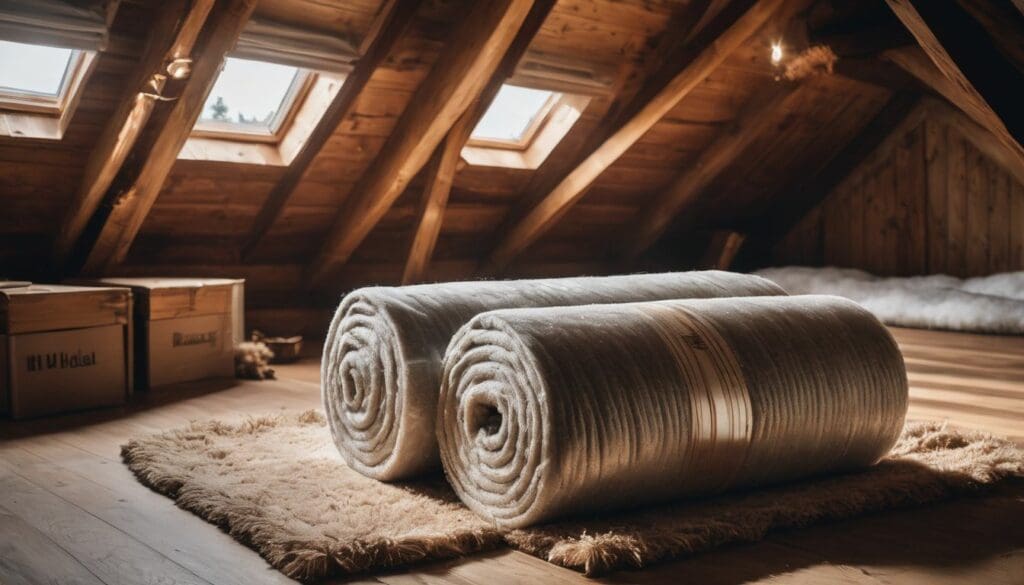Bracing against the biting chill of winter or weathering the relentless heat of summer, we all long for our abodes to be havens of comfort and models of energy efficiency. Like many folks, you might have felt those cheeky draughts slipping through antiquated insulation, a plight that led us on a quest for knowledge.
We unearthed quite the startling fact: a typical home can wave goodbye to roughly 25% of its warmth through an uninsulated roof. In this guide, we unwrap a plethora of eco-friendly insulation choices that promise to cradle your home in stable temperatures whilst honouring Mother Earth’s wellbeing.
Allow us to introduce you to sustainable cosiness tucked away within these very pages!
Key Takeaways
- Green insulation materials, including reclaimed wood, straw bales, and bamboo, reduce environmental impact by using renewable resources.
- Insulating homes with eco – friendly materials enhances energy efficiency, leading to lower utility bills and reduced energy consumption.
- Materials like hempcrete not only insulate but also improve indoor air quality due to their moisture-regulating abilities.
- Sustainable insulation can combine aesthetic appeal with functionality, adding character and warmth to homes while being environmentally conscious.
- When selecting the right green insulation for your home, consider factors such as cost – effectiveness over time, local availability of materials, and specific installation needs.
Why Insulation is Important in Eco-Friendly Construction
Insulation is crucial in eco-friendly construction because it helps improve energy efficiency by reducing heat loss and gain, ultimately lowering the carbon footprint of a building.
Understanding thermal resistance (R-value) is key to choosing the right insulation materials for sustainable construction.
Understanding R-Value and Thermal Resistance
We see R-value as a measure of insulation’s ability to resist heat flow. The higher the R-value, the greater that material’s thermal resistance and effectiveness in preventing heat loss or gain.
This is crucial for any green home seeking to maintain comfortable temperatures using less energy.
Choosing materials with optimal R-values ensures our homes stay warm in winter and cool in summer without over-relying on heating and cooling systems. We focus on eco-friendly home insulation that provides excellent thermal insulation options while also being sustainable.
Properly selected, these materials not only cut down energy bills but also reduce our carbon footprint, aligning with our environmental goals.
The Role of Insulation in Energy Efficiency
Insulation plays a crucial role in enhancing energy efficiency within our homes. By effectively insulating our living spaces, we can minimise heat loss during colder months and reduce the need for excessive cooling during hotter seasons.
This not only helps to maintain a comfortable indoor temperature but also reduces the reliance on heating and air conditioning systems, ultimately leading to lower energy consumption and reduced utility bills.
Moreover, proper insulation contributes to creating a more sustainable living environment by lowering the overall carbon footprint of our homes. As environmentally conscious individuals, it’s essential to recognise that investing in quality insulation materials is an impactful way to promote energy conservation and reduce environmental impact.
Balancing Cost and Environmental Impact
To balance cost and environmental impact, it’s essential to consider the long-term benefits of green insulation materials. By weighing the initial investment against the energy savings and durability, one can make an informed decision.
Additionally, evaluating the availability of materials and installation requirements is crucial in ensuring a sustainable choice that aligns with both budget and environmental goals.
When selecting green insulation options, it’s vital to assess not only the upfront expenses but also factors such as resource renewability and recyclability. It’s imperative to prioritise eco-friendly alternatives that offer a good balance between cost-effectiveness and minimal environmental impact while delivering efficient thermal performance for sustainable home construction.
Top Green Insulation Materials
When it comes to green home insulation, there are a variety of sustainable materials to choose from such as reclaimed wood, straw bales, bamboo, hempcrete, recycled steel, rammed earth, cork and solar tiles.
Each material has its own unique environmental benefits and can contribute to the overall energy efficiency of your home.
Reclaimed Wood
Reclaimed wood is an excellent green insulation material that offers both environmental and aesthetic benefits. It involves repurposing old wood from demolished buildings, barns, or other structures, thereby reducing the need for new timber and minimising waste sent to landfills.
Utilising reclaimed wood as insulation promotes sustainability by conserving natural resources and decreasing the environmental impact associated with logging and manufacturing new materials.
Additionally, it adds a unique character and warmth to homes, creating a visually appealing interior while aligning with eco-conscious values.
When considering sustainable insulation options for your home, keep in mind the versatility of reclaimed wood which can be used in various forms such as boards or panels to suit different architectural styles and designs.
Straw Bales
Straw bales are a natural and renewable insulation material made from the stems of harvested grain crops. They offer excellent thermal resistance, making them an efficient way to keep homes warm in winter and cool in summer.
Not only are straw bales environmentally friendly due to their low embodied energy, but they also provide good sound insulation and have high R-values, contributing to energy efficiency in buildings.
Using straw bales as insulation can help reduce the overall environmental impact of construction projects while promoting sustainable living. This eco-friendly option is not only cost-effective but also supports the use of renewable resources for insulation needs.
Embracing straw bale insulation aligns with our commitment to green building materials for a more sustainable future.
Bamboo
Bamboo is a highly sustainable and renewable material for insulation. It grows rapidly and requires minimal resources to cultivate, making it an eco-friendly choice for environmentally conscious individuals.
Bamboo insulation also offers excellent thermal resistance and acoustic performance, contributing to energy efficiency in homes. Its natural properties make it a popular choice for green building materials due to its low environmental impact.
The use of bamboo as an insulation material aligns with the growing demand for sustainable home construction. As more individuals seek eco-friendly options, bamboo stands out as a viable solution that promotes conservation and environmental responsibility.
Hempcrete
Moving on from discussing bamboo as a green insulation material, let’s delve into the unique properties of hempcrete. Hempcrete, made from hemp fibers mixed with lime and water, offers excellent thermal performance while also being lightweight and breathable.
This natural composite not only insulates but also promotes healthy indoor air quality due to its moisture-regulating abilities. Furthermore, hemp cultivation absorbs carbon dioxide from the atmosphere, making it an eco-friendly choice for environmentally conscious individuals seeking sustainable home insulation options.
Recycled Steel
Recycled steel insulation is a sustainable option for eco-friendly construction. Using recycled steel helps reduce the environmental impact by repurposing materials and conserving natural resources.
This type of insulation offers high durability and fire resistance, making it an excellent choice for those seeking long-lasting and environmentally friendly insulation solutions.
Furthermore, recycled steel insulation provides outstanding thermal performance, contributing to energy efficiency in homes or buildings. Its use also supports the circular economy by promoting the reuse of materials rather than relying solely on new production.
Rammed Earth
Rammed earth, a traditional construction technique, involves compacting a mixture of earth, gravel, sand, and clay into sturdy walls. This ancient method provides excellent thermal mass properties and insulation capabilities for sustainable homes.
Rammed earth structures offer natural temperature regulation by storing heat during the day and releasing it at night. Additionally, this eco-friendly material requires minimal energy to produce and is often locally sourced.
The use of rammed earth contributes to reducing the carbon footprint in construction while promoting environmentally responsible building practices.
Cork
Cork, a natural and renewable insulation material, provides excellent thermal performance. Harvested from the bark of cork oak trees, it is a sustainable option for environmentally conscious homeowners.
Cork insulation offers high R-value, ensuring energy efficiency while reducing heating and cooling costs in eco-friendly homes. Its acoustic properties make it an ideal choice for noise reduction, creating a peaceful indoor environment.
Additionally, cork is resistant to mold and mildew, contributing to healthier indoor air quality. With its low environmental impact and durability, cork insulation stands as a top choice for those seeking green building materials that support conservation efforts.
Solar Tiles
Transitioning from sustainable cork insulation to innovative solar tiles, we are excited about the potential of this eco-friendly building material. Solar tiles integrate seamlessly into a home’s roof while harnessing solar energy to generate electricity.
The development of these photovoltaic cells is transforming roofs into functional, environmentally friendly power generators. With aesthetic appeal and increased energy efficiency, solar tiles represent an exciting advancement in green building materials.
Harnessing the sun’s energy to power homes offers both environmental and financial benefits, making solar tiles an appealing option for those seeking sustainable living solutions.
Benefits of Green Insulation Materials
Green insulation materials offer a range of benefits, including sustainability, energy efficiency, durability, renewable resources, acoustic performance, and aesthetic appeal. These materials are not only environmentally friendly but also contribute to a healthier and more comfortable living environment.
Sustainability
Sustainability is at the core of our green home insulation materials. By using natural, renewable resources like reclaimed wood, straw bales, bamboo, and cork, we reduce our environmental impact and support eco-friendly construction.
These materials also offer energy efficiency benefits by providing excellent thermal resistance and acoustic performance while maintaining a low impact on the environment.
Our commitment to sustainability extends beyond material choices. We consider the entire lifecycle of our insulation materials, from production to installation to disposal. Choosing sustainable insulation not only benefits your home but also supports conservation efforts for a healthier planet.
Energy Efficiency
Insulation materials play a crucial role in enhancing the energy efficiency of homes. By minimising heat transfer, these green insulation options help to maintain a comfortable indoor temperature without excessive reliance on heating or cooling systems.
This reduced dependency on artificial climate control not only promotes cost savings but also contributes to lowering the overall energy consumption, thereby decreasing the environmental impact associated with home operation.
Consequently, choosing sustainable and eco-friendly insulation materials can significantly enhance the energy efficiency of homes while aligning with conservation efforts.
In addition to reducing heat loss and gain, environmentally friendly insulation materials aid in creating an effective thermal barrier that minimises fluctuations in indoor temperatures.
Durability
Green insulation materials are known for their durability, which contributes to the long-term performance and sustainability of a building. These materials have a proven track record of withstanding wear and tear while maintaining their insulating properties, making them a reliable choice for eco-friendly construction projects.
By choosing durable green insulation options such as reclaimed wood, bamboo, or hempcrete, homeowners can benefit from reduced maintenance and replacement costs over time.
The durability of these sustainable insulation materials ensures that they continue to provide energy-efficient solutions for the lifetime of the building without compromising environmental integrity.
Renewable Resources
When choosing green insulation materials, it’s important to consider renewable resources. These materials are derived from natural sources that can be replenished over time, making them environmentally friendly options for sustainable home construction.
Renewable resources like reclaimed wood, bamboo, and cork contribute to lower environmental impact while providing effective insulation for energy-efficient homes. By opting for these natural insulation materials, you can support conservation efforts and reduce the carbon footprint of your living space.
Incorporating renewable resources into home insulation not only benefits the environment but also promotes a more eco-friendly lifestyle. Embracing these sustainable options aligns with the principles of green building and contributes to creating healthier living spaces while reducing reliance on non-renewable resources such as fossil fuels or synthetic materials.
Acoustic Performance
Green insulation materials not only contribute to energy efficiency and sustainability but also provide excellent acoustic performance. Using natural materials like cork, straw bales, and hempcrete can effectively dampen sound transmission, creating a quieter and more peaceful living environment.
Additionally, renewable resources like bamboo offer great acoustical properties due to their density and ability to absorb sound waves. Recycled steel insulation also provides soundproofing benefits in eco-friendly construction, ensuring a tranquil indoor space without compromising environmental consciousness.
Moreover, incorporating solar tiles into the roofing system not only harnesses clean energy but also helps in reducing outside noise infiltration. These green insulation materials are engineered to minimise unwanted noise from outdoor surroundings such as traffic or other environmental disturbances.
Aesthetic Appeal
After considering the acoustic performance of green insulation materials, it’s important to note their aesthetic appeal. The use of natural materials like reclaimed wood, bamboo, and cork can bring a warm and inviting feel to any space.
Additionally, the unique textures and earthy tones of straw bales, hempcrete, and rammed earth add character and charm to eco-friendly homes. These aesthetically pleasing options not only contribute to a sustainable living environment but also enhance the visual appeal of a property while showcasing an individual’s commitment to environmentally friendly choices.
The aesthetic appeal of these green insulation materials offers homeowners an opportunity to create visually stunning interiors while reducing their environmental impact. Choosing natural and renewable resources for insulation not only contributes positively towards sustainability efforts but also adds a touch of natural beauty to any home or building interior.
Factors to Consider When Choosing Green Insulation Materials
Consider cost, availability, installation requirements and the environmental impact before choosing green insulation materials for your home. Read on to discover more about these important factors in making an eco-friendly choice for your insulation needs.
Cost
When selecting green insulation materials, it is essential to consider the cost. Although some sustainable options may have a higher initial price tag, they often provide long-term savings due to improved energy efficiency and durability.
It’s crucial to weigh the upfront expenses against potential future benefits such as reduced utility bills and lower maintenance costs.
It’s important to note that while cost is a significant factor in choosing eco-friendly insulation, it should not be the sole consideration. The overall environmental impact, availability of materials, and installation requirements are also vital factors to take into account when making an informed decision for your sustainable home insulation solution.
Availability
When considering green insulation materials, availability is a crucial factor to take into account. Some materials such as reclaimed wood, straw bales, and hempcrete may not be widely available in all regions.
It’s important to research local suppliers and understand the logistics of sourcing these materials for your project. On the other hand, recycled steel, cork, and solar tiles might have better availability due to their growing popularity in sustainable construction.
Understanding the availability of green insulation options in your area will help you make an informed decision that aligns with your environmental values while ensuring practicality for your project.
Considering the availability of eco-friendly insulation can also impact the carbon footprint associated with transportation. Choosing locally available materials reduces emissions from long-distance transportation and supports local economies.
Installation Requirements
When considering green insulation materials for your home, it’s essential to factor in the installation requirements. Assessing the cost and availability of the chosen material is crucial, as well as understanding its impact on the environment.
Additionally, ensuring that the insulation meets formaldehyde-free and recycled content criteria is important for sustainable construction.
Properly evaluating all aspects of the installation process will help you select an environmentally friendly option that aligns with your values while providing effective thermal resistance and energy efficiency in your home.
Environmental Impact
Green insulation materials offer a more environmentally friendly alternative to traditional options, reducing the carbon footprint of building projects. By using natural and renewable resources such as bamboo, hempcrete, and reclaimed wood, we can minimise the impact on our planet while improving energy efficiency.
These sustainable materials are also free from harmful chemicals like formaldehyde, ensuring a healthier indoor environment for both occupants and ecosystems. Additionally, choosing green insulation supports conservation efforts by utilising recycled content and low-impact production methods, making it an ideal choice for those seeking to build eco-friendly homes.
As environmentally conscious individuals supporting conservation efforts, we have the opportunity to make a positive difference through our choice of insulation materials. Opting for green alternatives not only reduces our environmental impact but also contributes to creating healthier living spaces for generations to come.
The Future of Sustainable Insulation
As technology continues to advance, we can expect to see even more sustainable insulation options entering the market. These advancements will have a significant impact on the building industry and help to further reduce the environmental impact of construction.
Advancements in Green Insulation Technology
Green insulation technology has seen significant advancements in recent years, with a focus on sustainability and energy efficiency. Manufacturers have been developing innovative materials that incorporate recycled content, such as cellulose insulation options and formaldehyde-free alternatives.
These environmentally friendly insulation options not only reduce the carbon footprint but also provide effective thermal resistance for homes and buildings. Additionally, advancements in renewable insulation materials like bamboo and hempcrete have contributed to low-impact home insulation choices, catering to the needs of eco-conscious individuals seeking sustainable solutions.
Furthermore, green building insulation has embraced energy-efficient home insulation through the development of nontoxic options that prioritise environmental conservation without compromising performance.
The introduction of solar tiles has also revolutionised the industry by offering dual functionality – providing both energy generation and thermal resistance for sustainable homes.
Impact on the Building Industry
Green insulation materials are revolutionising the building industry, leading to a shift towards more sustainable construction practices. These eco-friendly alternatives contribute to reducing energy consumption and carbon emissions, aligning with the growing demand for environmentally responsible building solutions.
Manufacturers are increasingly incorporating recycled and renewable resources into their insulation products, promoting a greener approach to construction that prioritises energy efficiency and environmental impact.
As demand for these materials continues to rise, they are driving innovation in the industry, inspiring advancements in green insulation technology and influencing building codes and standards.
The adoption of sustainable insulation materials is reshaping how buildings are designed and constructed, encouraging a proactive approach towards minimising environmental impact across the entire lifecycle of structures.
FAQ on Eco-Friendly Insulation Options
When considering eco-friendly insulation options, it’s important to be well-informed. Here are some frequently asked questions about green insulation materials:
- What are the best natural insulation materials for houses?
- Reclaimed wood, straw bales, bamboo, hempcrete, and rammed earth are all excellent choices for sustainable home insulation.
- Are there energy – efficient home insulation options that also offer acoustic performance?
- Yes, cork is a great example of a green insulation material that provides both energy efficiency and effective soundproofing.
- How do recycled steel and solar tiles contribute to sustainable home insulation?
- Recycled steel offers durability and thermal resistance, while solar tiles contribute to energy efficiency by harnessing renewable solar power.
- What are the low – impact home insulation choices that don’t compromise on environmental impact?
- Hempcrete and cork stand out as natural insulators that not only have low environmental impact but are also renewable resources.
- Can formaldehyde-free insulation materials still offer high R-value and thermal resistance?
- Absolutely! Natural insulation materials like hempcrete and cork can provide excellent thermal performance without the use of harmful chemicals.
- How do I judge the availability of green insulation materials in my area?
- Researching local suppliers is crucial when considering the availability of eco – friendly insulators such as reclaimed wood or straw bales.
- Are there any advancements in green insulation technology to look forward to in the future?
- The building industry is constantly evolving with new techniques such as developments in solar tile technology and innovative uses of recycled materials.
Conclusion
In conclusion, green insulation materials offer a range of benefits for eco-friendly construction. They provide sustainable, energy-efficient, and durable options that also contribute to acoustic performance and aesthetic appeal in homes.
As advancements continue in green insulation technology, we can expect to see a positive impact on the building industry as more environmentally conscious individuals opt for low-impact home insulation choices.
Whether it’s reclaimed wood, bamboo, or hempcrete, these nontoxic insulation options play a key role in creating sustainable homes while supporting conservation and environmental efforts.
FAQs
1. What makes insulation materials green or eco-friendly?
Green or eco-friendly insulation materials include options like recycled content insulation, formaldehyde-free alternatives, and cellulose, all designed to create energy-efficient homes with a lower environmental impact.
2. Are there non-toxic options for home insulation?
Yes, there are non-toxic insulation choices available that provide safe and sustainable ways to insulate your home without harmful chemicals.
3. Can installing green home insulation save energy?
Absolutely! Utilising eco-friendly insulation materials in your house significantly increases the energy efficiency of your home, reducing the need for heating and cooling.
4. Why should I consider using low-impact home insulation choices?
Opting for low-impact home insulation contributes to building sustainable homes and helps preserve our environment by minimising waste and avoiding toxic substances.





